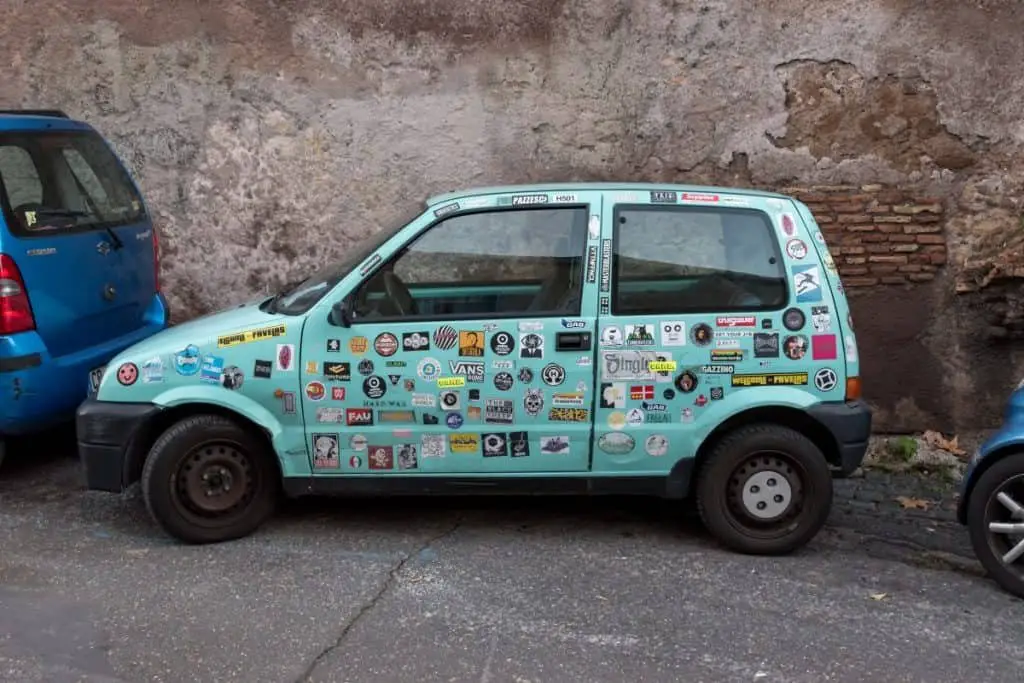This post contains affiliate links.
Vinyl stickers are an easy way to liven up a blank space or personalize an item. There are vinyl decals for everything from mugs and laptops to walls and nail art. But can you use vinyl stickers on your car?
Vinyl stickers are safe for most surfaces of your car. Temporary vinyl will not damage your windows or your paint, but it won’t last very long exposed to the elements. Permanent outdoor vinyl will last longer and give you the best result. It won’t damage your car if you remove it carefully.
Keeping safety in mind, you can decorate your car with vinyl decals without worry. Even if you’re using permanent vinyl, you can remove a decal when it gets sun-faded or damaged. Vinyl decals are a great way to give your car a personal touch. If you are still looking for a vinyl cutter, check out my article Best Vinyl Cutting Machines.

Cricut Sales! Save up to 50% OFF on Materials and Accessories. Plus, get up to $150 off Machines and Heat Presses!
|
Can Vinyl Damage Your Car?
If you apply them and remove them properly, vinyl stickers or decals will not damage your car. The adhesive on any craft vinyl that you can use with your Cricut or Silhouette machine is no match for the sealants and treatments that cars get to protect them from the elements. Discover which cutting machine is better in my article, Cricut vs Silhouette for Stickers.
It’s more likely that the sun, rain, and dirt that hits your car every day will damage the decal than the decal will damage the car. If you’re worried, you can always use a tiny piece of vinyl in an out-of-the-way part of your car to test and see how it does with the adhesive.
Will Vinyl Stickers Damage Your Car’s Paint?
The vinyl sheets you can use in your die-cutting machine are strong enough to stick to your car, but they aren’t strong enough to damage your car. Automotive paint is very thick and durable and is sealed with a coating to protect it from the UV rays of the sun. The sticky backing off your vinyl isn’t going to eat through that paint.
Most of the damage that a vinyl sticker or decal can do to your car is actually accidental protection. Despite the UV coating, car paint does eventually fade in the sun. Any area you have covered with a vinyl decal will protect that area from the sun. When you take off a decal after a long time, you might notice that your car is darker or less faded where the sticker was.

How to Apply a Vinyl Sticker to Your Car
No matter what kind of vinyl you choose, applying it properly is the key to your car sticker standing up to the elements and lasting a long time. To apply your vinyl sticker you will need:
- a lint free cloth
- soapy water
- rubbing alcohol
- a squeegee or flexible plastic card
To apply your vinyl sticker to your car you’ll need to thoroughly clean the area where you want to apply it with soap and water. Make sure there is no dirt or dust in the area and completely dry the area with a lint free cloth.
Once the area is clean and dry you should wipe down the spot with some rubbing alcohol. This removes any oils from the surface. Rubbing alcohol will not hurt your paint as long as you use a solution of 10-15% isopropyl alcohol. You’ll likely need to dilute your rubbing alcohol to get the right ratio.
If your vinyl car sticker is a complicated design with lots of little pieces then it likely came with some transfer tape over top of the design. The transfer tape allows you to peel your design off the carrier sheet (sticker backing) and keep all the little pieces in the right spot. A simple shape may not need transfer tape
For a simple shape, simply remove the backing from the sticker and apply the sticker on your car. Gently but firmly rub your squeegee or plastic card over the sticker. Start from the inside and work your way out. This helps the vinyl adhesive to fully adhere to your car.
For more complicated designs that use transfer tape, start by flipping the design over so it is face down. Start peeling the carrier sheet away from the transfer sheet and vinyl design at a 45-degree angle. If you notice any parts of the vinyl remaining on the carrier sheet, stick the carrier sheet back down and rub down the back of the sheet with your squeegee this is known as burnishing.
Once the carrier sheet or liner is removed you can place your vinyl sticker on your car. Again you will gently but firmly rub your squeegee or plastic card over the sticker. Start from the inside and work your way out.
Once you’ve burnished your whole design, start peeling back the transfer tape at a 45 degree angle. Again if any pieces of vinyl remain on the transfer sheet, lay that portion back down and rub it with your squeege tool.
Now that you have fully removed the transfer tape, I recommend burnishing your design again. This will make sure your design is well adhered to your vehicle and will last a long time.
Even after carefully applying your vinyl decal you might notice some air bubbles. You can use your squeegee to push these bubbles out to the edge of your design.
If you find you have a stubborn air bubble that just doesn’t want to budge use a pin and prick a tiny hold in the middle of the bubble. Then you can squeegee the air out. Just know that if your design is light in color the pinhole might be slightly noticeable. But since this is a car sticker it’ll likely get dirty soon enough and never be noticeable.
How To Remove Vinyl Decals From Your Car
Removing a vinyl decal from your car takes more elbow grease than anything else. Even if the decal is old and starting to peel, getting all of the remaining adhesive off your car will take some effort.
To make it easier, you can gently heat up the area around the sticker with a hairdryer. Do not use a heat gun, as too much heat will damage the paint on your car. Use a medium heat setting on the hairdryer to loosen the adhesive.
Once the decal is loose, peel it away from your car at a diagonal angle. You can use a blunt scraping tool, like the Cricut burnishing tool or a plastic rewards card, to help ease the sticker up. Don’t use a metal scraper as this can scratch and damage your car.
After all of the vinyl is gone, there will probably still be adhesive or adhesive residue on your vehicle. You can scrub it with plain white vinegar or use a glue-remover to wipe it off. Amazon.com sells Goo Gone Adhesive Remover Wipes that you can use to get rid of any sticky residue easily.
It’s a good idea to wash the area of your car where the decal was (or your whole car!) to get rid of any remaining residue or goo remover. Then your car should look as good as new.
What Kinds of Vinyl Are Safe for Your Car?
The kinds of vinyl you can use in your cutting machine are almost all going to be safe for your car. You can’t use heat transfer or iron-on vinyl, but any kind of adhesive vinyl should work well. Because of the exposure cars get to wind, rain, sun, and dirt, a permanent or outdoor adhesive vinyl will give you the longest-lasting results.
My favorite place to buy vinyl is Expressions Vinyl. They have a huge selection of permanent vinyl and temporary vinyl. I like to use Oracal 651 for all my permanent outdoor vinyl projects.

Permanent vs. Temporary Vinyl for Car Decals
The best choice for a car decal is an outdoor, permanent vinyl. You want permanent unless you’re hoping to take the decal off after a few days. Even if you live somewhere with a mild climate, the decal will still get a lot of dirt and wind thrown against it as you drive your vehicle.
Outdoor and permanent vinyl resists fading, heat, cold, dirt, grit, and precipitation. You can even take your car through a carwash without ruining your vinyl stickers. Permanent doesn’t mean you can never take it off your car; it just means it won’t come off your car by itself.
Temporary vinyl has a weaker adhesive bond. It will still stick to your car because the smooth, hard surfaces of a vehicle are perfect for adhesive vinyl. However, it will fade faster and is more likely to get scratched or start peeling off as it isn’t as durable as permanent vinyl.
Printable Vinyl for Car Decals
You can do a lot with outdoor vinyl, but if you’re hoping for a multi-color design that you can make with print and cut, there isn’t a long-lasting outdoor option. Printable vinyl isn’t the best option for car decals. It can be used but it will likely fade quickly in the elements.
You want to make sure you purchase a permanent printable vinyl. Cricut’s printable vinyl is a removable/temporary vinyl that will not last long on a vehicle. I don’t recommend using this on a car unless your design is meant to be short term.
Expression Vinyl sells a permeant printable vinyl. It states on the site the “Outdoor Durability: 1 year (without a laminate)”. Sealing it is one option to help extend the life of it.
A sprayable polyurethane seal like Minwax Fast-Drying Polyurethane Aerosol, sold on Amazon, is easy to apply. Just make sure you seal your sticker BEFORE you apply it to your car.
Printable vinyl can be used with any inkjet printer and opens up a lot of fun options using your Cricut or Silhouettes Print-then-Cut feature. Learn more about printable vinyl in my article, How Printable Vinyl works.
If you are looking for a new printer to make your vinyl decals, check out my article Best Vinyl Sticker Printer.
Can You Put Vinyl Decals on Your Car Windows?
The outside of your windows is one of the best parts of your car for a vinyl decal. The glass of the windows offers a smooth, hard surface that is easy to clean, which makes it easier to apply the decal. Car windows are also a reasonably flat surface, so your design is less likely to come out warped or skewed.
You should be mindful of the driver’s sightlines when you place decals on the windows. As cute as the design might be if it’s a safety hazard, it’s a bad idea. The lower corners of the back windshield are a good spot to show off your design without blocking the view.
Windshield wipers can shorten the lifespan of your car sticker, so you may want to place it out of reach of the wiper. Dirt and debris caught in the wiper blade can scrape the sticker, scratching the surface, or even peeling it back. The wiper’s path is also a good indication of where the driver needs to see.
If you are concerned about placing your decal on the defrost lines on your rear windshield, don’t worry. Your vinyl sticker will stand up to the heat the defrost puts out. To be honest, your windows will likely get hotter in the summer sun than the defrost does in the middle of winter.

Final Thoughts
Vinyl decals are a fun way to dress up your car and add a personal touch without damaging your car. The paint treatments on your car are stronger than your adhesive vinyl, so as long as you remove them carefully, you won’t damage your car’s paint job. Clean windows also offer a great canvas for car decals. The durability of permanent outdoor vinyl lets you explore your creativity with long-lasting, car-safe stickers.

